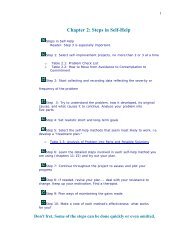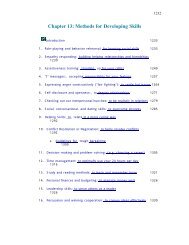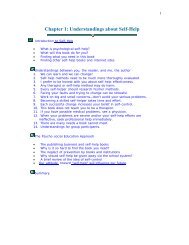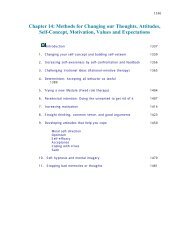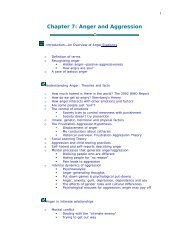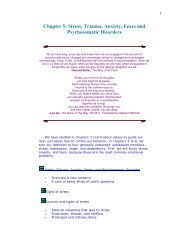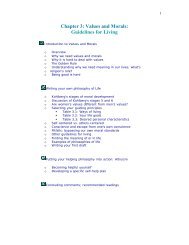Methods for Changing Behaviors - Psychological Self-Help
Methods for Changing Behaviors - Psychological Self-Help
Methods for Changing Behaviors - Psychological Self-Help
Create successful ePaper yourself
Turn your PDF publications into a flip-book with our unique Google optimized e-Paper software.
your schedule; make a public pledge and so on), (2) permit no<br />
exceptions until the new habit is established, and (3) seize the first<br />
opportunity to act on every resolution you make ("the road to hell is<br />
paved with good intentions" that never get acted on). Well, some<br />
things haven't changed in 100 years.<br />
William James also gave another bit of advice, a self-help method<br />
called the "as if" technique. He said, "If you want a quality, act as if<br />
you already had it."<br />
It may be wise to start with an easier situation or behavior and<br />
work up to more challenging circumstances. Get at it. You are building<br />
a stimulus cue (external or internal, i.e. self-talk)--new behavior-reward<br />
sequence. Record and reward your progress.<br />
Try a thing you haven't done three times. Once, to get over the fear of doing it. Twice, to<br />
learn how to do it. And a third time to figure out whether you like it or not.<br />
-Virgil Thomson<br />
Time involved<br />
Developing a new dependable response is seldom easy. It may<br />
take an hour or two to consider new options, especially if you do some<br />
reading or talk to a friend. It may take another hour or so to devise<br />
new self-talk and behavior. It will take more time to practice and try<br />
out the newly learned behavior. Total=2 to 4 hours. Keep in mind that<br />
many, many new responses might be involved in changing from a shy,<br />
scared, quiet, poorly in<strong>for</strong>med person into the opposite. So, the<br />
impossible takes a little longer.<br />
Common problems with the method<br />
Not sticking with it; pessimistic attitudes; giving up after the first<br />
defeat; deciding you want to do something else when the going gets<br />
tough. And, backsliding when you move on to work on some other<br />
self-improvement.<br />
Effectiveness, advantages, and dangers<br />
People do change, presumably through some process like this (see<br />
chapter 4). Research has shown repeatedly that people learn new<br />
behaviors from models. An advantage is that this method focuses on<br />
mental and behavioral processes that are related to almost any selfimprovement.<br />
1081



